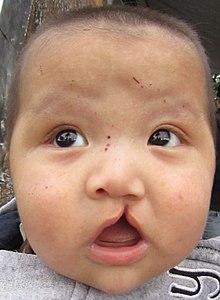List of hereditary diseases
This list of hereditary diseases contains some of the most common hereditary diseases in humans. A distinction is made between benign diseases and tumor diseases.
Benign hereditary diseases
| illness | Inheritance | Chromosome / gene | description |
|---|---|---|---|
| Albinism | Autosomal recessive | Chromosome 11 , locus q14-21, chromosome 15 , locus q11-13, chromosome 9 , locus p23, chromosome 5 , locus p13.3 | Lack of synthesis of melanin leads to light or white hair, eyes and skin color |
| Alpha-1 antitrypsin deficiency | Autosomal recessive | Chromosome 14 , locus q32.1 | An increased risk of liver cirrhosis or pulmonary emphysema due to a congenital lower concentration of this enzyme |
| Chorea huntington | Autosomal dominant | Chromosome 4 , locus p16.3 | Fatal motor and mental disorders due to the increased incorporation of glutamine in the protein huntingtin |
| Galactosemia | Autosomal recessive | Chromosome 9 | If left untreated, the intracellular storage of galactose is often fatal due to the lack of the enzyme galactose-1-phosphate uridyl transferase |
| Hemophilia A. | X-linked | X chromosome | Increased bleeding tendency due to a lack of coagulation factor VIII |
| Hemophilia B. | X-linked | X chromosome | Increased bleeding tendency due to a lack of coagulation factor IX |
| cretinism | Autosomal recessive or dominant | Multiple genes, e.g. B. Chromosome 2 , locus q14.1 and chromosome 14 , locus q31.1 | Short stature, deformity of the limbs, speech disorders and intellectual disorders caused by a congenital deficiency of thyroid hormone ( thyroxine ) |
| Cleft lip and palate | Polygenetic | (multiple genes) | Congenital splitting of the lips, upper jaw, roof of the mouth, or a combination of these |
| Metachromatic Leukodystrophy | Polygenetically autosomal recessive | (multiple genes) | Unsteady gait, speech disorders due to lack of aryl sulfate |
| Mucopolysaccharidosis type 1 | Polygenetically autosomal | (multiple genes) | Different symptoms that only appear in childhood due to the storage of glycosaminoglycans in cells. |
| Cystic fibrosis | Autosomal recessive | Chromosome 7 , locus q31.2 | Dysfunction of the lungs and pancreas due to the formation of tough mucus, leading in the end stage to lung failure or pancreatic insufficiency |
| Neurofibromatosis | Autosomal dominant (spontaneous mutation in 50% of cases) | Chromosome 17 , locus q11.2 | Development of benign tumors on the skin, in the eyes and bones, and in the central nervous system |
| Phenylketonuria | Autosomal recessive | Chromosome 12 , locus q22 to q24 | Impaired brain development and skull growth due to a lack of the enzyme phenyl alanine hydroxylase |
| Sickle cell disease | Autosomal codominant | Chromosome 11 | Deformities of the red blood cells lead to painful crises; symptomatic only in the homozygous form |
| Spinal muscular atrophy | Autosomal recessive | Chromosome 5 , locus q13 | Muscle wasting due to the loss of motor nerve cells in the spinal cord |
| Tay-Sachs syndrome | Autosomal recessive | Chromosome 15 , locus q23-24 | Severe intellectual disability with blindness from birth; the fewest children affected are older than three years |
| Cystic kidneys | Autosomal recessive | Chromosome 16 | Development of multiple cysts in the kidneys from adulthood, leading to renal failure in the end-stage |
Hereditary tumor diseases
- Hereditary malignant melanoma
- Hereditary breast cancer
- Familial adenomatous polyposis coli (FAP)
- Hereditary non-polyposis colorectal cancer (HNPCC)
- Juvenile Polyposis coli
- Li Fraumeni Syndrome
- Multiple endocrine neoplasia, type 1 (MEN 1)
- Multiple endocrine neoplasia, type 1 (MEN 2)
- Renal carcinoma, clear cell
- Renal carcinoma, papillary
- Peutz-Jeghers Syndrome
- Retinoblastoma
- Wilms tumor
literature
- Jan Diether Murken, pocket textbook human genetics , Thieme Verlag, Stuttgart 2017
- Christian P. Schaaf, Basic Knowledge of Human Genetics , Springer-Verlag, Berlin-Heidelberg 2013


